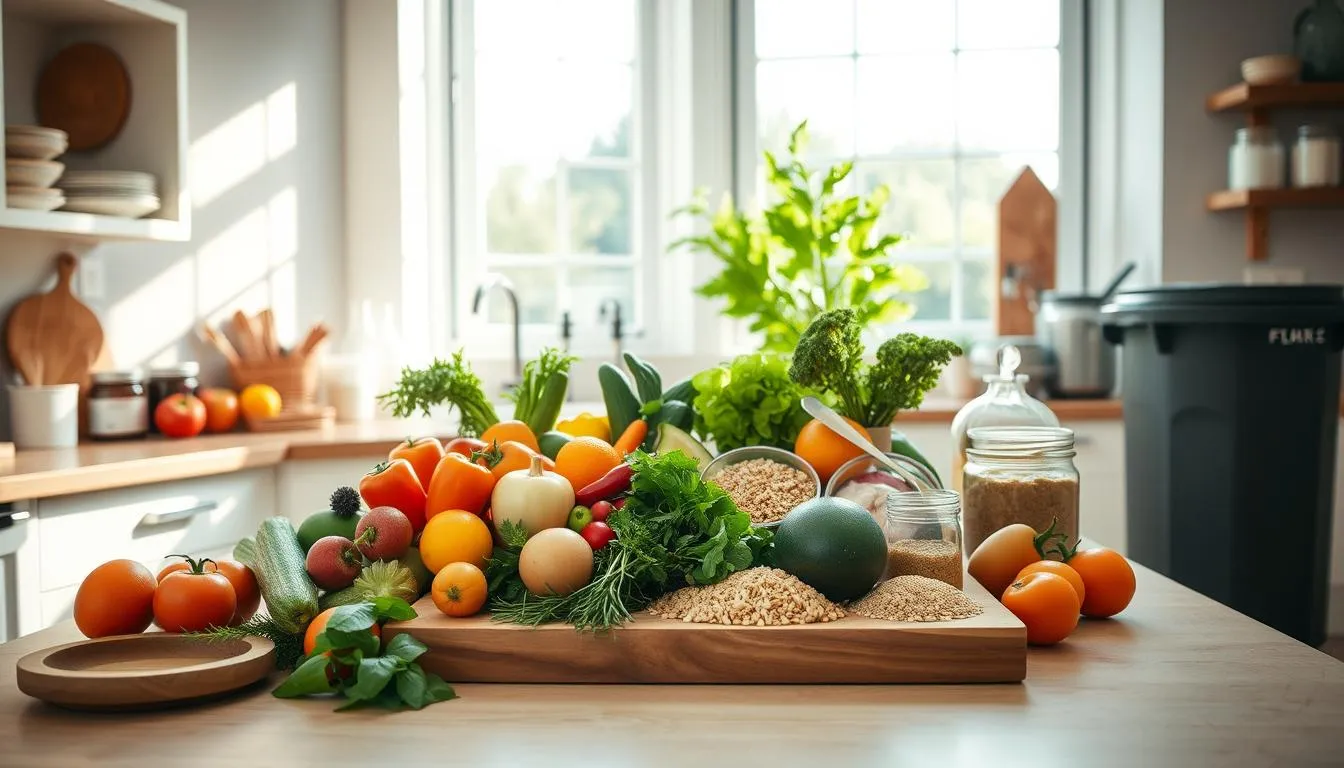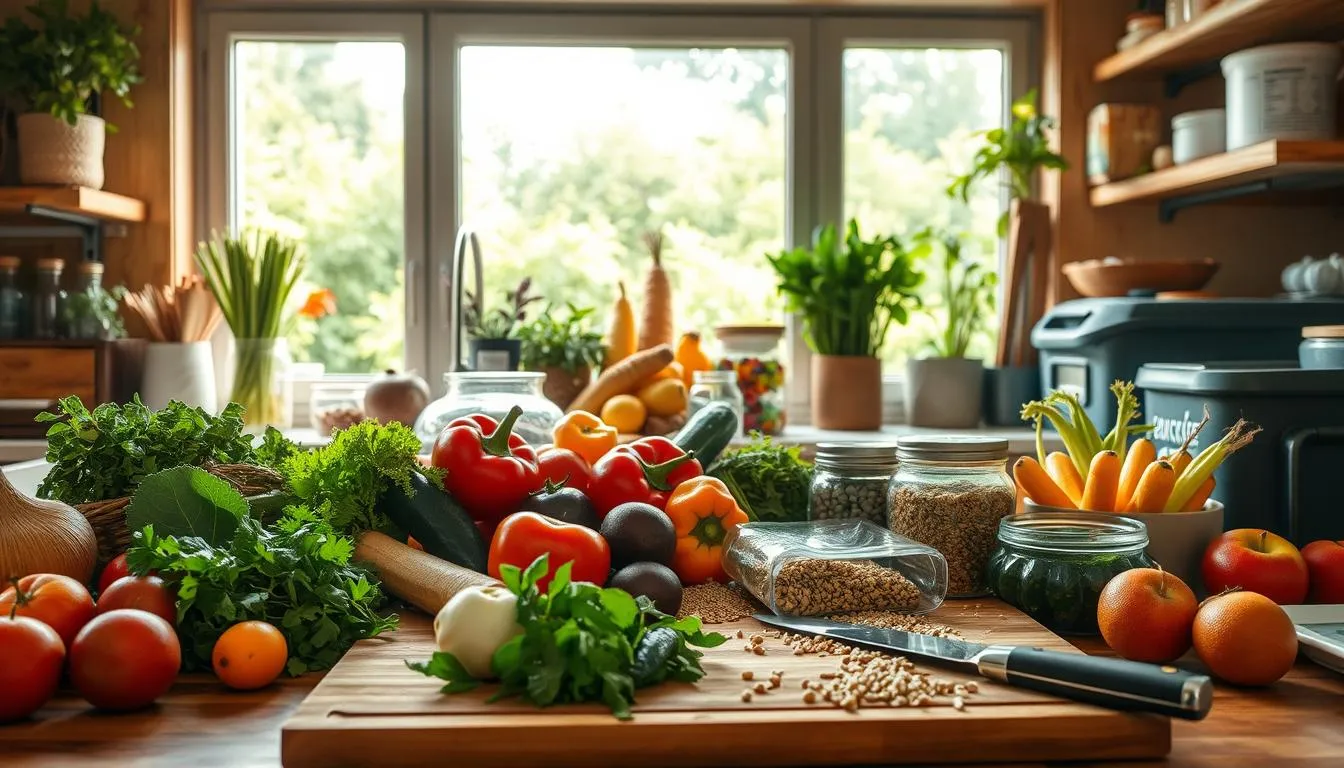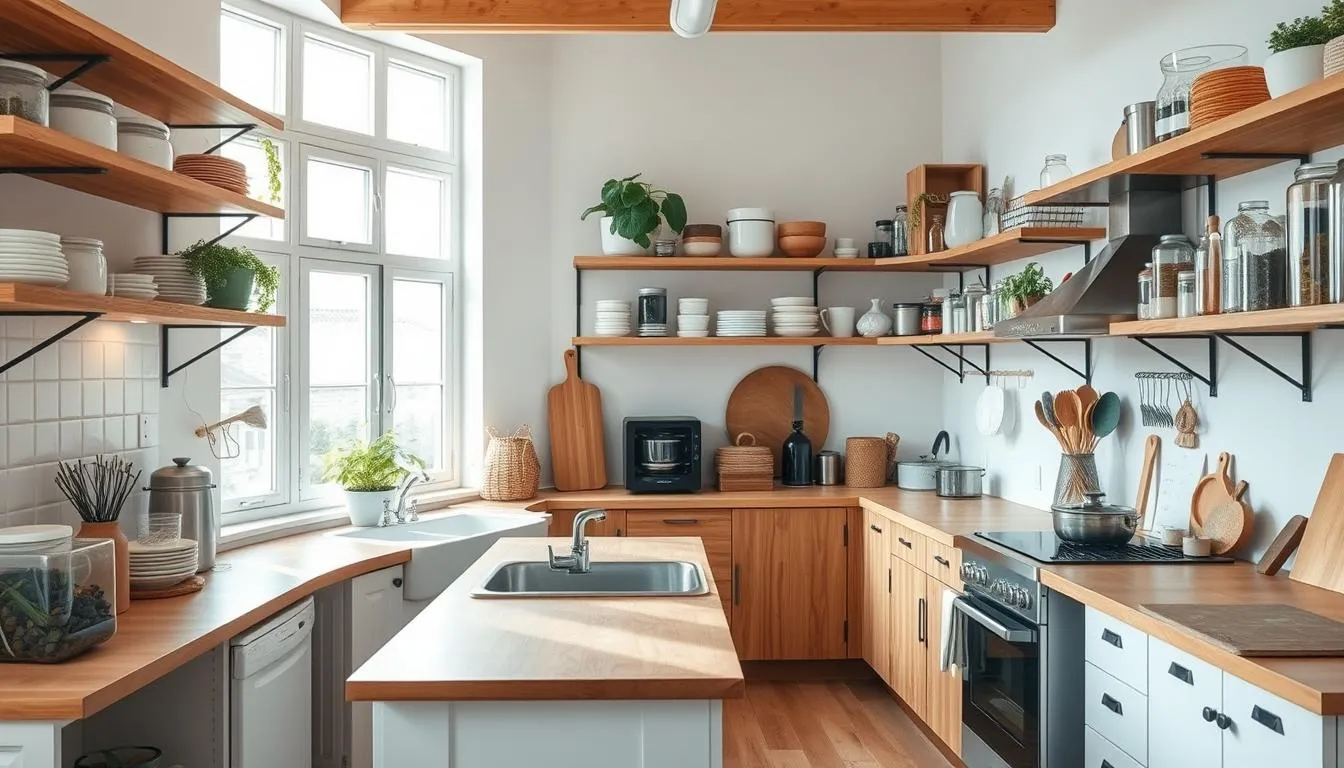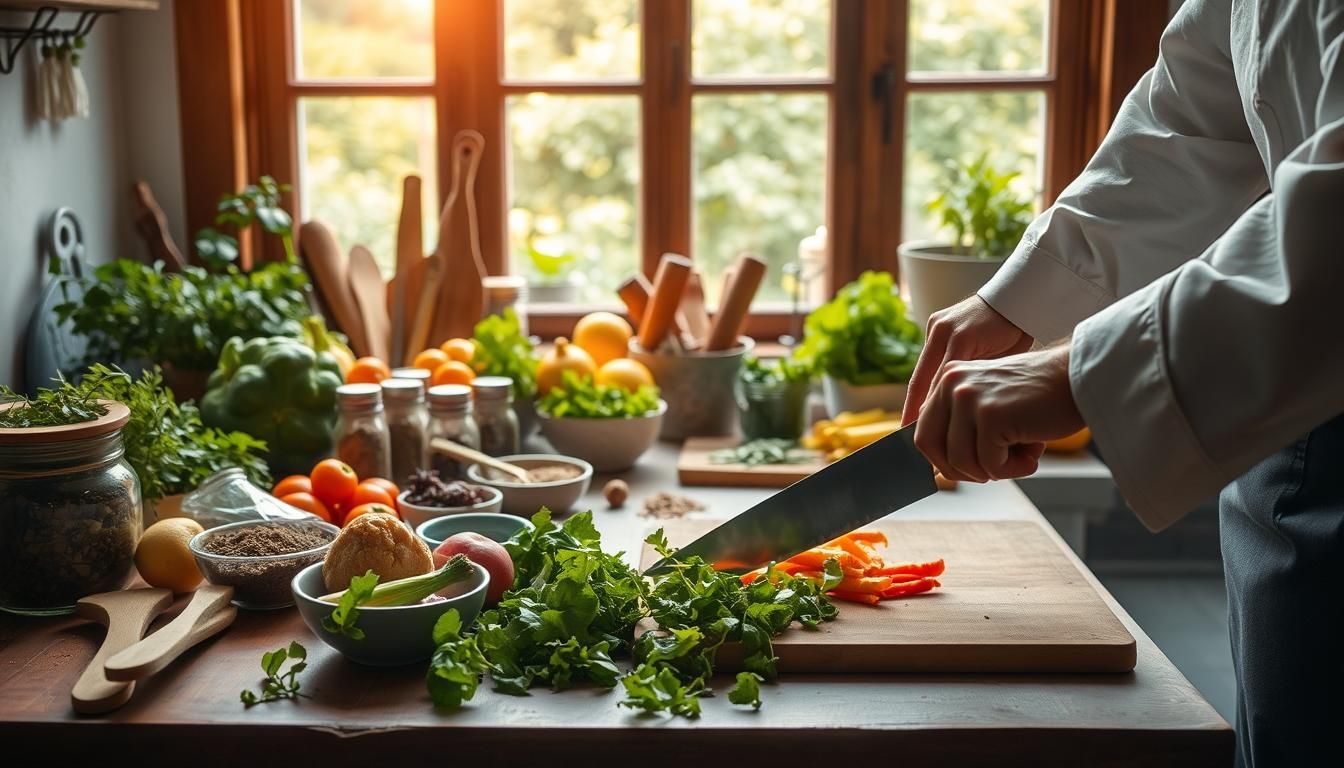There are nights when I stand in front of a fridge full of good intentions and wonder what to do next. I felt the same frustration until small habits changed my kitchen and my mood.
Zero-waste cooking is a friendly, practical way to keep tasty meals and less trash. It uses simple moves like smart planning, saving scraps, and basic preservation to stretch ingredients and cut food bills.
The facts are clear: America tosses huge amounts of food and packaging every year. That makes the need to act feel urgent, but also doable at home with tools you already have.
This guide will show how to get started with repeatable ways to plan, store, freeze, pickle, and transform peels and stems into rich stock. Small changes can save money, reduce waste, and make your kitchen more joyful.
Key Takeaways
- Begin with meal planning to reduce extra food and trips to the store.
- Use preservation methodsfreezing, pickling, dehydratingfor longer life.
- Turn peels and stems into stocks, infusions, or purees before composting.
- Simple tools and habits can cut waste and help you save money fast.
- Pick one or two new ways this week to build a sustainable kitchen routine.
What ZeroWaste Cooking Means Today
A practical kitchen routine helps households waste less while keeping meals satisfying.
Zero-waste cooking is a simple way to cut food and packaging losses by shopping with intent, cooking manageable servings, and reusing edible scraps. It focuses on three actions: reduce extras, reuse trimmings, and recycle organics through compost.
Reduce food overload by planning portions that fit your household. Smaller portions and shared recipes stop uneaten plates from becoming garbage.
Reuse means turning stems into pesto, saving vegetable and meat scraps for broth, freezing cheese rinds for soup, or roasting seeds for snacks. These small moves stretch ingredients and add flavor.
 Recycling organics keeps compostable food out of landfills. Remember: perfection isnt the goal. Progress over time matters more than an all-or-nothing approach.
Recycling organics keeps compostable food out of landfills. Remember: perfection isnt the goal. Progress over time matters more than an all-or-nothing approach.
- Quick audit: list three items you toss most and pick one fix.
- Easy first steps: save a jar of scraps for broth and freeze single portions of grains.
| Action | Example | Benefit |
|---|---|---|
| Reduce | Plan servings, buy bulk | Less food waste, lower cost |
| Reuse | Broth from peels, pesto from stems | More flavor, fewer scraps |
| Recycle | Compost or community pickup | Keeps organics out of landfill |
Why It Matters: Benefits for your wallet, health, and the planet
A few smarter choices in the kitchen can lower bills and shrink your household footprint.
Huge losses happen every year: in the United States, 2540% of food is discarded about 133 billion pounds and $161 billion in value. Packaging and containers add more than 23% of landfill trash, and roughly 45% of landfill material ties to food and food packaging.
Wasted food drives emissions. The food system makes about 13% of global greenhouse gases, and rotting food adds nearly 8% more through methane. So when you reduce food waste and skip single-use food packaging, you cut emissions, save water and energy used to grow ingredients, and can save money on groceries.

- Health: cooking with whole ingredients often improves diet quality and lowers exposure to packaging chemicals.
- Financial: plan meals to use the same items twice, preserve extras, and stretch proteins with grains and vegetables to save money.
- Community: share surplus with neighbors or food-rescue apps to keep good food in circulation.
One simple step today: scan your fridge, cook the most perishable items tonight, and freeze the rest for another meal. Small, consistent ways you shop and cook add up to measurable reductions in waste at home.
Plan, Shop, and Store: The foundation of a zerowaste kitchen
Small steps in planning, shopping, and storing make your kitchen far more efficient.
Smart meal planning
Plan meals around perishables first. Map fragile items to the start of the week, then layer in pantry staples so smaller portions dont languish.
Choose two anchor ingredients and cook them two ways. This reduces decision fatigue and makes sure leftovers get used.
Shopping habits that stick
Bring jars and bags for bulk bins and skip extra food packaging when you can. Check dates and estimate shelf life so you only buy what you will use.
“Build a list that sequences meals by fragility salad greens first, root vegetables later.”
Storage to extend shelf life
Organize the fridge by zones: an “eat first” shelf up front, raw items below cooked foods, and humidity drawers set for leafy versus hearty produce.
- Portion grains and proteins into freezer-ready sizes and label with date.
- Store fast-staling items like nuts and flours in the fridge or freezer to keep flavor.
- Do a Sunday 10-minute scan to make sure aging foods are cooked, frozen, or repurposed.

Preservation 101: Freeze, dehydrate, pickle, and jam without waste
Preserving seasonal bounty keeps food flavorful and your pantry ready all year.
Freezing basics
Freeze smarter: blanch vegetables for better texture, portion broths and pesto into cubes, and stash milk or yogurt for smoothies and baking later.
Freeze bananas and grapes for quick snacks. Freeze-cut stone fruits on a tray first so pieces don’t clump.
Dehydrate and dry
Use a dehydrator or a low oven to make apple chips and dry peppers into chile powder. No dehydrator? Keep the oven door slightly ajar and rotate trays for even drying.
Pickling and canning
Quick refrigerator pickles are ready in hours and keep for weeks. Use water-bath canning when you want shelf-stable jars that last months.
Jam and seasonal preserves
Make small refrigerator jams from peak fruits now, and water-bath can larger batches to enjoy the season later.
- Keep a preservation station with clean jars, lids, and labels.
- Start with one method this week freeze or pickle to build confidence.
- For more practical tips, read these zero-waste cooking tips.
Repurpose Scraps: Creative ways to use every part
A simple freezer bag can turn kitchen peelings into your next favorite stock. Collect clean scraps onion peels, herb stems, and carrot tops and freeze them until you have enough to simmer a clear, rich broth.
Save Parmesan or other cheese rinds in the freezer and drop one into pots of beans or soup for instant umami. Use those ingredients to deepen flavor without buying more food.
Turn overripe fruit into quick purees for yogurt or pancakes. Spread thin and dry for chewy fruit leather kids love. Infuse mushroom stems, apple peels, or citrus tops into vinegars, oils, or creams, then compost the aromatics after extracting flavor.
- Keep a labeled bag for clean food scraps and make broth on the weekend.
- Roast squash seeds with spices for a crunchy snack.
- Reuse coffee grounds and crushed eggshells as gentle garden fertilizer.
Make a small “cook next” bin so every part gets a purpose. This habit is a great way to get creative and cut household waste while practicing practical zero-waste cooking.
Composting and Eating Out: Practical ways to reduce waste beyond cooking
You can close the loop between your plate and the garden with simple composting and mindful dining choices.
What to compost, what to skip, and how to get started at home
Compost transforms kitchen scraps into rich soil. Compost fruits and vegetables, eggshells, coffee grounds, and tea bags. These items break down quickly and feed plants.
Make sure to skip dairy, meat, bones, and oils in a home pile. They attract pests and slow the process. Start with a small sealed caddy for daily trimmings, then use a backyard bin, tumbler, worm bin, or a municipal program to finish the job.
Restaurant and takeout strategies
When you eat out, bring a lightweight reusable container and utensils. Ask for no disposable cutlery and decline extra napkins or condiments you won’t use.
Choose restaurants that use compostable food packaging or donate surplus. Order directly from the restaurant to reduce extra bags and inserts. Share plates or ask for smaller portions to avoid leftovers.
- Get started by keeping a sealed counter pail for scraps.
- Check local curbside rules before adding questionable items.
- Pack reuseable containers and say no to single-use cutlery.
- Support spots with compostable packaging and food donation policies.
These simple ways extend zero-waste cooking habits beyond home. They cut food packaging and reduce waste without losing convenience. For more practical kitchen changes, see this how-to guide.
Conclusion
Small, steady habits in the kitchen add up to big cuts in what we toss each year.
Plan, preserve, and repurpose to reduce food waste: cook perishables first, freeze blanched vegetables and broths, and dehydrate or pickle extra fruit and vegetables to extend life.
Turn food scraps and peels into stock or infusions. Roast seeds and use coffee grounds and eggshells as gentle fertilizer for the garden. These parts and ingredients create value instead of trash.
Make a simple promise: pick one thing to start todayfreeze broth cubes, set a compost caddy, or roast seedsand add another next week. That is a practical way to build a sustainable kitchen and keep good foods in use rather than letting them go to waste.
FAQ
What does zerowaste cooking mean in everyday kitchens?
It means using ingredients and parts so little food goes to the trash. Focus on planning meals, buying the right amounts, storing food to extend life, and turning peels, stems, and bones into broths, purees, or snacks. Aim for steady improvement rather than perfect results.
How can I reduce food waste when meal planning and shopping?
Start with a simple meal plan and a shopping list that matches portion needs. Buy in bulk for staples like rice and beans, choose loose produce to avoid excess packaging, and check useby dates. Keep smaller portions in mind and freeze extras instead of tossing them.
What are easy storage tips to keep fruits and vegetables fresh longer?
Store leafy greens in a damp towel inside a sealed container, keep root vegetables in the crisper, and use airtight jars for opened sauces. Freeze herbs in oil or stock as cubes, and blanch then freeze surplus vegetables to preserve color and texture.
How do I make flavorful broth from scraps?
Save onion peels, carrot tops, celery ends, herb stems, and cheese rinds in a freezer bag. When you have enough, simmer with water and seasoning for 12 hours, then strain. Freeze broth in portions or use it right away for soups and grains.
Can I preserve foods without special equipment?
Yes. Freeze fruits and vegetables, make quick refrigerator pickles, and cook smallbatch jams on the stovetop. For dehydrating, use a low oven setting on a tray with airflow. Canning needs jars and a water bath, but many methods dont require a full setup.
What parts of produce should I keep for repurposing?
Save skins, peels, stems, and seeds when edibleapple peels for chips or vinegar, citrus zest for flavoring, beet greens sautd, and pumpkin seeds roasted. Some parts work for food; others are better for compost or fertilizer.
How do I turn coffee grounds and eggshells into fertilizer?
Spread used coffee grounds thinly on soil or mix into compost for nitrogen. Crush eggshells and sprinkle around plants to deter slugs and add calcium. Both break down and enrich garden soil over time.
What should I compost at home and what should I avoid?
Compost fruit and vegetable scraps, coffee grounds, eggshells, and tea leaves. Avoid meat, dairy, oily foods, and diseased plant material in small home piles; these can attract pests or cause odors. Use a wellmanaged bin or municipal program for broader scraps.
How can I reduce waste when eating out or ordering takeout?
Bring reusable containers and utensils, request no singleuse items, and choose restaurants that offer compostable packaging. Order rightsized portions or share dishes, and ask for sauces on the side to avoid soggy leftovers.
Are there simple snacks or dishes I can make from usually discarded parts?
Yeskale stems can be pickled or blended into pesto, cucumber peels crisped for snacks, and watermelon rinds pickled. Grind roasted seeds and shells into snack mixes or add ground coffee to chocolate bark for flavor.
How do I start if I feel overwhelmed by changing kitchen habits?
Begin with one habit: freezing leftovers, saving scraps for broth, or bringing reusable bags to the store. Small steps save money and reduce packaging and wasted food. Gradually add preservation and composting as you gain confidence.
Which household appliances help reduce food spoilage most effectively?
A reliable refrigerator with proper temperature control, a freezer for longterm storage, and an airtight vacuum sealer or simple jars make a big difference. A good knife and cutting board help you use whole produce more easily.
